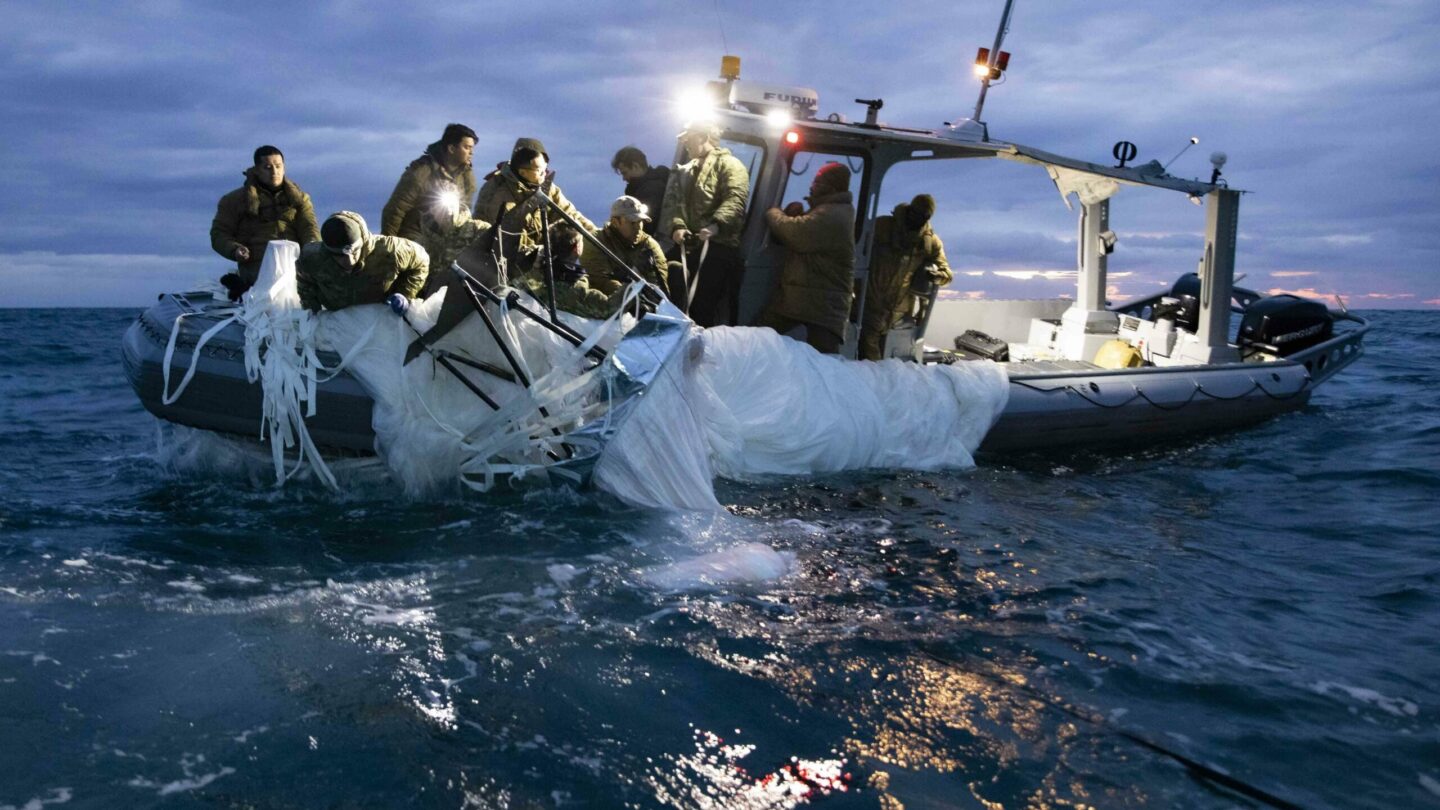U.S. fighter jets have shot down four high-altitude objects this month — including the first instance in which U.S. Northern Command “has taken kinetic action against an airborne object” in U.S. airspace over its nearly 65-year existence, according to the unit’s commanding officer, Gen. Glen VanHerck.
The shootdowns came in steady succession over the weekend, after alarms were raised in early February over an object that the U.S. said was a surveillance balloon deployed by China.
China has accused the U.S. of flying its own spy balloons over China — a claim rejected by Secretary of State Antony Blinken.
“We do not send spy balloons over China, period,” Blinken told NPR’s Morning Edition.
With the other recently downed objects yet to be publicly identified, speculation has included questions of whether they might be alien UFOs.
No sign of alien activity, the White House says
“There is no – again, no — indication of aliens or extraterrestrial activity with these recent takedowns,” White House press secretary Karine Jean-Pierre said at Monday’s daily press briefing.
John Kirby, a spokesperson for the National Security Council, told reporters that “all manner of innocuous craft” can fly at the same altitudes. That includes aircraft used by companies and countries for purposes that are “not nefarious at all.”
Kirby also said all three objects most recently shot down over the U.S. and Canada were determined not to pose a direct threat to people on the ground. They were also found to be uncrewed and to have limited abilities, from a lack of communication signals to a lack of obvious propulsion capability.
Here’s what we know so far about these takedowns, from the questions that they raise to where recovery operations stand:
What’s behind the surge of unexplained objects?
It can be attributed at least in part to increased scrutiny, including enhanced radar techniques, Assistant Secretary of Defense for Homeland Defense and Hemispheric Affairs Melissa G. Dalton said on Sunday.
The U.S. has been on the alert to look for spy balloons and unauthorized objects since a Chinese balloon caused a national sensation and political outrage. That incident, Dalton said, also helped the U.S. learn more about what to look for in detecting similar objects. That process includes adjusting radar-filtering systems known as “gates,” VanHerck added.
“You can set various gates” to filter radar information, VanHerck said. “We call them velocity gates that allow us to filter out low-speed clutter.”
A lot more information is available, the general said, when lower speeds are included rather than filtered out.
“We have adjusted some of those gates to give us better fidelity on seeing smaller objects,” VanHerck said. “You can also filter out by altitude. And so, with some adjustments, we’ve been able to get a better a categorization of radar tracks now. And that’s why I think you’re seeing these overall.”
Why do people keep asking if these are alien ships?
When U.S. officials describe these incidents, they often use language that’s purposefully vague, such as “high altitude airborne objects.” It’s an attempt to be accurate while still reporting preliminary data, but the approach can be intriguing, and it also provokes public speculation.
For instance, here’s Pentagon Press Secretary Brig. Gen. Pat Ryder from last Friday, talking about that day’s shootdown: “We have no further details about the object at this time, including any description of its capabilities, purpose, or origin.”
When a reporter asked VanHerck on Sunday if the U.S. military has ruled out potential actions by extraterrestrials, he did not dismiss the idea.
“I haven’t ruled out anything,” he said. “At this point, we continue to assess every threat or potential threats unknown that approaches North America with an attempt to identify it.”
“We call them objects for a reason,” VanHerck said. And while the initial incident involved a balloon, he added, “These are objects. I am not able to categorize how they stay aloft. It could be a gaseous type of balloon inside a structure or it could be some type of a propulsion system. But clearly, they’re — they’re able to stay aloft.”
Starting with the most recent object, here’s what we know so far about these takedowns, drawing on U.S. and Canadian officials’ statements:
Feb. 12: Lake Huron
Location and altitude: The object was around 20,000 feet, soaring near the eastern portion of Michigan’s Upper Peninsula. It was shot down over Lake Huron, “about 15 nautical miles east of the Upper Peninsula,” VanHerck said.
Size and shape: “It presented as an octagonal structure with strings hanging off but no discernable payload,” a senior Biden administration official said.
What shot it down: An F-16, firing an AIM-9X Sidewinder missile.
Reason given: “We did not assess it to be a kinetic military threat to anything on the ground,” the North American Aerospace Defense Command said, “but assess it was a safety flight hazard and a threat due to its potential surveillance capabilities.”
Recovery effort: “Our team will now work to recover the object in an effort to learn more,” NORAD said. The location of the shootdown, the unit says, was chosen both to limit risks to people and to boost the chance of recovering debris.
Feb. 11: Yukon, Canada
Location and altitude: Approximately 40,000 feet, in Canada’s central Yukon, after crossing the border from Alaska. The shootdown took place around 100 miles from the U.S.-Canada line.
Size and shape: Early indications showed “this object is potentially similar” to the one shot down off the South Carolina coast, Canadian Defense Minister Anita Anand said, adding that it was “smaller in size and cylindrical.”
What shot it down: An F-22 fired an AIM-9X Sidewinder missile, said Ryder, the Pentagon press secretary.
Reason given: “The object … had unlawfully entered Canadian airspace [and] posed a reasonable threat to the safety of civilian flight,” Anand said.
Recovery effort: “Canadian Forces will now recover and analyze the wreckage of the object,” Canadian Prime Minister Justin Trudeau said. The effort includes the Royal Canadian Mounted Police and Canadian Special Operations Forces, with the FBI acting as a liaison.
Feb. 10: Alaskan coast
Location and altitude: It was at 40,000 feet, over Prudhoe Bay along Alaska’s northern coast.
Size and shape: “The object was about the size of a small car,” Ryder told reporters, adding that it was “not similar in size or shape to the high-altitude surveillance balloon” from the previous weekend.
What shot it down: An F-22 fired an AIM-9X Sidewinder missile.
Reason given: It “posed a reasonable threat to the safety of civilian flight,” Ryder said.
Recovery effort: “Recovery activities are occurring on sea ice,” as allowed by Arctic weather, limited daylight and other conditions, the U.S. Northern Command said on Saturday.
Feb. 4: South Carolina coast
Size and shape: The balloon was estimated to be up to 200 feet tall. Of the payload, VanHerck said, “I would categorize that as a jet airliner type of size, maybe a regional jet,” with a weight of more than 2,000 pounds.
Location and altitude: The balloon famously crossed much of the continental U.S. before being shot down over the Atlantic Ocean, near Myrtle Beach, S.C. It was flying between 60,000 and 65,000 feet.
What shot it down: An F-22 Raptor using an AIM-9X Sidewinder missile.
Reason given: The large intruder was part of a “fleet of balloons developed to conduct surveillance operations, which have also violated the sovereignty of other countries,” a senior U.S. defense official told reporters.
Recovery effort: Some wreckage from the balloon was gathered from the Atlantic Ocean’s surface. Divers and remote-operated vehicles were also used in “the retrieval of additional debris from the sea floor,” according to the U.S. Northern Command. The FBI is involved, taking custody of debris as it’s brought onshore.
On Thursday morning, a U.S. Navy Landing Craft Air Cushion — basically a high-capacity hovercraft — parked on a beach to retrieve a range of supplies and food for the crew, from fresh produce to Chick-Fil-A and a birthday cake, local paper The Sun News reports.
Copyright 2023 NPR. To see more, visit https://www.npr.org.
9(MDAxODM0MDY4MDEyMTY4NDA3MzI3YjkzMw004))

9(MDAxODM0MDY4MDEyMTY4NDA3MzI3YjkzMw004))








